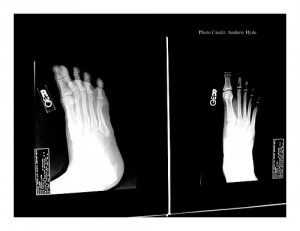By: Sarah McWilliams

One of the more common injuries in professional and recreational athletes is a stress fracture of the foot. Stress fractures result from multiple small injuries within the bones of your feet that accumulate and result in a fracture. Dr. Kenneth Jung of the Kerlan-Jobe Orthopaedic Clinic tells ATLX, “If your activity level is beyond your body’s ability to heal on a daily basis you can get a stress reaction, which can progress to a stress fracture with continued activity.”
New or different training habits have habituated stress fractures in everyday athletes and weekend warriors alike. With the increase in participation in marathons and mud runs, athletes are increasing their mileage substantially and putting more stress on their body.
Another cause of stress fractures is the increase in the barefoot running trend. Dr. Jung says, “I tell people they have to gradually build up their mileage.” Although studies continually show that barefoot running is actually optimal to decrease the stress on your body that running can cause, people are hopping on the bandwagon without giving their bodies time to acclimate to this new form.
Who is at risk?
 If you have recently changed your workout routine significantly, your chances are higher to incur a stress fracture. Also, if you have gone from a lower impact routine to a higher impact routine – for example, swimming to sprinting – then your chances are also elevated.
If you have recently changed your workout routine significantly, your chances are higher to incur a stress fracture. Also, if you have gone from a lower impact routine to a higher impact routine – for example, swimming to sprinting – then your chances are also elevated.
Those who switch from cushioned shoes to a more minimalist shoe, or no shoes at all without giving the body ample time to adjust, are also more likely to incur stress fractures on their feet. Health care providers typically see more stress fractures in athletes training for a specific event, because they increase their mileage dramatically without giving the body enough time to adjust.
Signs and Symptoms
If you feel pain in your feet that lasts more than a week, then it’s time to head to your health care provider to have it checked out. Dr. Jung also recommends seeing your health care provider if you’re having pain doing daily activities like walking around, not just when you’re doing strenuous physical activity.
A stress fracture will also have local tenderness. If it is especially painful when pushing on a specific point, then a stress fracture could be the cause.
Prevention
 “In general, it’s just exercising in moderation,” Dr. Jung tells ATLX. “Cross training is a good thing. It’s a good rule not to do the same workout everyday.” By alternating your high impact and low impact workouts and by ranging mileage on different days, you can avoid putting too much stress on the bones in your feet.
“In general, it’s just exercising in moderation,” Dr. Jung tells ATLX. “Cross training is a good thing. It’s a good rule not to do the same workout everyday.” By alternating your high impact and low impact workouts and by ranging mileage on different days, you can avoid putting too much stress on the bones in your feet.
Treatment
Relieving the pressure from the feet is the first step in treating a stress fracture. Because stress fractures are typically caused when an athlete increases the pressure on their feet, switching to low impact exercises can help heal a stress fracture. Bone growth stimulators can also encourage bone growth and aid in healing. Dr. Jung also recommends taking calcium and vitamin D to aid in healing.
“It may not be healed in a couple of weeks but the pain can improve over the course of two weeks just by eliminating the stress and stressful activity,” Dr. Jung says.
 ATLX The only sports entertainment television and digital media network fully devoted to everyday athletes, athletic lifestyle and athletic culture.
ATLX The only sports entertainment television and digital media network fully devoted to everyday athletes, athletic lifestyle and athletic culture.




